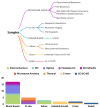Innovative Methodologies for the Early Detection of Breast Cancer: A Review Categorized by Target Biological Samples
- PMID: 40277570
- PMCID: PMC12026102
- DOI: 10.3390/bios15040257
Innovative Methodologies for the Early Detection of Breast Cancer: A Review Categorized by Target Biological Samples
Abstract
Innovative biosensor technologies are revolutionizing cancer detection by offering non-invasive, sensitive, and rapid diagnostic tools, addressing the limitations of conventional screening. Non-invasive samples like breath, saliva, urine, and sweat, analyzed using advanced technologies like electronic nose systems and AI, show promise for early detection and frequent monitoring, though validation is needed. AI integration enhances data analysis and personalization. While blood-based methods remain the gold standard, combining them with less invasive sample types like saliva or sweat, and using sensitive techniques, is a promising direction. Conventional methods (mammography, MRI, etc.) offer proven efficacy, but are costly and invasive. Innovative methods using biosensors offer reduced infrastructure needs, lower costs, and patient-friendly sampling. However, challenges remain in validation, standardization, and low biomarker concentrations. Integrating both methodologies could create a comprehensive framework, combining reliability with accessibility. Future research should focus on robust biosensor development, standardization, expanding application to other cancers, exploring less-studied samples like sweat, and improving affordability for wider adoption, especially in resource-limited settings. The future lies in integrating diverse approaches for more sensitive, specific, and patient-friendly screening, improving early detection and outcomes.
Keywords: biosensor technologies; early detection; non-invasive cancer detection.
Conflict of interest statement
The authors declare no conflicts of interest.
Figures




Similar articles
-
Electrochemical biosensors for early detection of breast cancer.Clin Chim Acta. 2025 Jan 1;564:119923. doi: 10.1016/j.cca.2024.119923. Epub 2024 Aug 15. Clin Chim Acta. 2025. PMID: 39153652 Review.
-
Field effect transistor based wearable biosensors for healthcare monitoring.J Nanobiotechnology. 2023 Nov 7;21(1):411. doi: 10.1186/s12951-023-02153-1. J Nanobiotechnology. 2023. PMID: 37936115 Free PMC article. Review.
-
Non-invasive Biodiversified Sensors: A Modernized Screening Technology for Cancer.Curr Pharm Des. 2019;25(38):4108-4120. doi: 10.2174/1381612825666191022162232. Curr Pharm Des. 2019. PMID: 31642768 Review.
-
Non-invasive bioassay of Cytokeratin Fragment 21.1 (Cyfra 21.1) protein in human saliva samples using immunoreaction method: An efficient platform for early-stage diagnosis of oral cancer based on biomedicine.Biomed Pharmacother. 2020 Nov;131:110671. doi: 10.1016/j.biopha.2020.110671. Epub 2020 Aug 24. Biomed Pharmacother. 2020. PMID: 32853907
-
Recent advances in bioactive materials: Future perspectives and opportunities in oral cancer biosensing.Talanta. 2025 May 1;286:127494. doi: 10.1016/j.talanta.2024.127494. Epub 2024 Dec 31. Talanta. 2025. PMID: 39799882 Review.
Cited by
-
Innovative Approaches to Early Detection of Cancer-Transforming Screening for Breast, Lung, and Hard-to-Screen Cancers.Cancers (Basel). 2025 Jun 2;17(11):1867. doi: 10.3390/cancers17111867. Cancers (Basel). 2025. PMID: 40507348 Free PMC article. Review.
-
Comparing the effectiveness of gratitude intervention and behavioral activation technique in breast cancer patients: a randomized trial.BMC Cancer. 2025 Jul 28;25(1):1226. doi: 10.1186/s12885-025-14492-3. BMC Cancer. 2025. PMID: 40722069 Free PMC article.
References
-
- IARC International Agency for Research on Cancer. 2024. [(accessed on 14 April 2025)]. Available online: https://www.iarc.who.int/
-
- American Cancer Society . Breast Cancer Facts & Figures 2021–2022. American Cancer Society; Atlanta, GA, USA: 2022.
Publication types
MeSH terms
LinkOut - more resources
Full Text Sources
Medical

